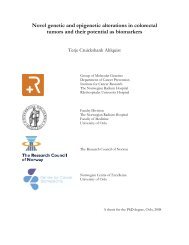Preface - Ous-research.no
Preface - Ous-research.no
Preface - Ous-research.no
Create successful ePaper yourself
Turn your PDF publications into a flip-book with our unique Google optimized e-Paper software.
Surgical Intensive Care Medicine<br />
Leader:<br />
Ansgar O. Aasen, Professor, MD, PhD (UiO/OUH)<br />
Scientific staff:<br />
Ola Sveen, Prof., MD, PhD (UiO)<br />
Tom Erik Ruud, Senior scientist, MD, PhD (OUH)<br />
Yngvar Gundersen, Senior scientist, MD, PhD (OUH)<br />
Claus Danckert Krohn, Consultant, MD, PhD (OUH)<br />
Johanna Samulin-Erdem, Senior scientist, PhD (OUH)<br />
David Kunke, Senior scientist, PhD (OUH)<br />
Kristin Bjørnland, Consultant, MD, PhD (OUH)<br />
Yun Yong Wang, MD, PhD (OUH)<br />
Claus Vinter Bødker Hviid, MD, PhD-student (OUH)<br />
Signe Flood Kjeldsen, Research engineer, MSc (UiO)<br />
Research area<br />
Infections following surgery or trauma continue to be a<br />
major clinical problem. Due to the immu<strong>no</strong>logical consequences<br />
of surgery, infections frequently develop into severe<br />
septic complications and multiple organ injuries. The problem<br />
in severe sepsis is a paradoxical and self-destructing<br />
inflammation leading to dysfunctional host defense and<br />
lethal injury to vital organ systems.<br />
More than one million patients are expected to die annually<br />
from severe sepsis world wide.<br />
Aims<br />
Our aim is to develop <strong>no</strong>vel means to prevent or ameliorate<br />
the self-destructive inflammation in patients with infection.<br />
A major focus of our work is <strong>research</strong> into the cellular<br />
mechanisms involved.<br />
Ongoing Projects in 2010:<br />
Molecular mechanisms in the development of sepsis-induced<br />
Multiple organ dysfunction<br />
Sepsis remains a challenging problem in intensive care<br />
medicine. Much is k<strong>no</strong>wn about the immune-pathophysiological<br />
mechanisms in sepsis, but the mechanisms behind<br />
sepsis-induced organ failure are still a matter of debate.<br />
The clinical outcome of sepsis is directly correlated to the<br />
number of organs failing, as the mortality inclines from 25%<br />
in single organ failure to above 72% with failure of three or<br />
more organs.<br />
Professor Ansgar O. Aasen<br />
To address this critical aspect of sepsis two <strong>no</strong>vel projects to<br />
investigate molecular mechanisms involved in the development<br />
of sepsis-induced organ failure, have been initiated.<br />
CCN proteins in the development of sepsis-induced organ<br />
failure<br />
The CCN proteins belong to a group of extracellular matrix<br />
(ECM)-associated proteins that have emerged as potential<br />
candidates in the regulation of parenchyma function.<br />
The protein family has a regulatory rather than structural<br />
role in the ECM and includes the six proteins CCN1 (Cyr61),<br />
CCN2 (CTGF), CCN3 (NOV), CCN4 (Wisp-1), CCN5 (Wisp-2)<br />
and CCN6 (Wisp-3). Their synthesis is induced by multiple<br />
factors including serum growth factors, cytokines, steroids,<br />
hypoxia, and mechanical and environmental stressors. The<br />
proteins function primarily through interaction with cell adhesion<br />
receptor integrins, which allows for variation in the<br />
response due to integrin subtype specific effects in different<br />
cell types. The role of CCN proteins in the development of<br />
sepsis-induced organ failure has <strong>no</strong>t been investigated.<br />
Research has previously worked with the role of CCN2 in<br />
development of liver fibrosis as well as the roles of several<br />
CCN proteins in the development of cardiovascular failure.<br />
However, possible roles of these proteins have also been<br />
indicated during acute lung and kidney injury. Interestingly,<br />
the CCN proteins also affect inflammatory responses by<br />
modulating the production of cytokines and reactive oxygen<br />
species, and by stimulating adhesion and migration of<br />
lymphocytes and mo<strong>no</strong>cytes/macrophages.<br />
Initial studies have been conducted in two different rodent<br />
models of abdominal sepsis induced by cecal ligation and<br />
puncture (CLP). In a short-term model using male wistar<br />
rats the animals were divided in three groups; Baseline,<br />
9
















